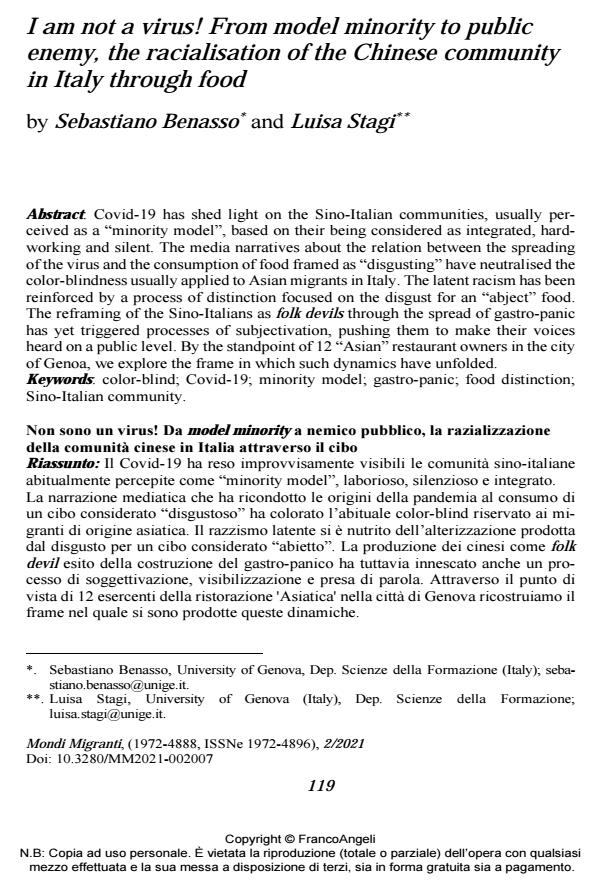I am not a virus! From model minority to public enemy, the racialisation of the Chinese community in Italy through food
Journal title MONDI MIGRANTI
Author/s Sebastiano Benasso, Luisa Stagi
Publishing Year 2021 Issue 2021/2
Language Italian Pages 15 P. 119-133 File size 193 KB
DOI 10.3280/MM2021-002007
DOI is like a bar code for intellectual property: to have more infomation
click here
Below, you can see the article first page
If you want to buy this article in PDF format, you can do it, following the instructions to buy download credits

FrancoAngeli is member of Publishers International Linking Association, Inc (PILA), a not-for-profit association which run the CrossRef service enabling links to and from online scholarly content.
Covid-19 has shed light on the Sino-Italian communities, usually perceived as a "minority model", based on their being considered as integrated, hard-working and silent. The media narratives about the relation between the spreading of the virus and the consumption of food framed as "disgusting" have neutralised the color-blindness usually applied to Asian migrants in Italy. The latent racism has been reinforced by a process of distinction focused on the disgust for an "abject" food. The reframing of the Sino-Italians as folk devils through the spread of gastro-panic has yet triggered processes of subjectivation, pushing them to make their voices heard on a public level. By the standpoint of 12 "Asian" restaurant owners in the city of Genoa, we explore the frame in which such dynamics have unfolded.
Il Covid-19 ha reso improvvisamente visibili le comunità sino-italiane abitualmen-te percepite come "minority model", laborioso, silenzioso e integrato. La narrazione mediatica che ha ricondotto le origini della pandemia al consumo di un cibo considerato "disgustoso" ha colorato l’abituale color-blind riservato ai mi-granti di origine asiatica. Il razzismo latente si è nutrito dell’alterizzazione prodotta dal disgusto per un cibo considerato "abietto". La produzione dei cinesi come folk devil esito della costruzione del gastro-panico ha tuttavia innescato anche un pro-cesso di soggettivazione, visibilizzazione e presa di parola. Attraverso il punto di vista di 12 esercenti della ristorazione 'Asiatica' nella città di Genova ricostruiamo il frame nel quale si sono prodotte queste dinamiche.
Keywords: color-blind; Covid-19; minority model; gastro-panic; food distinction; Sino-Italian community.
Sebastiano Benasso, Luisa Stagi, I am not a virus! From model minority to public enemy, the racialisation of the Chinese community in Italy through food in "MONDI MIGRANTI" 2/2021, pp 119-133, DOI: 10.3280/MM2021-002007